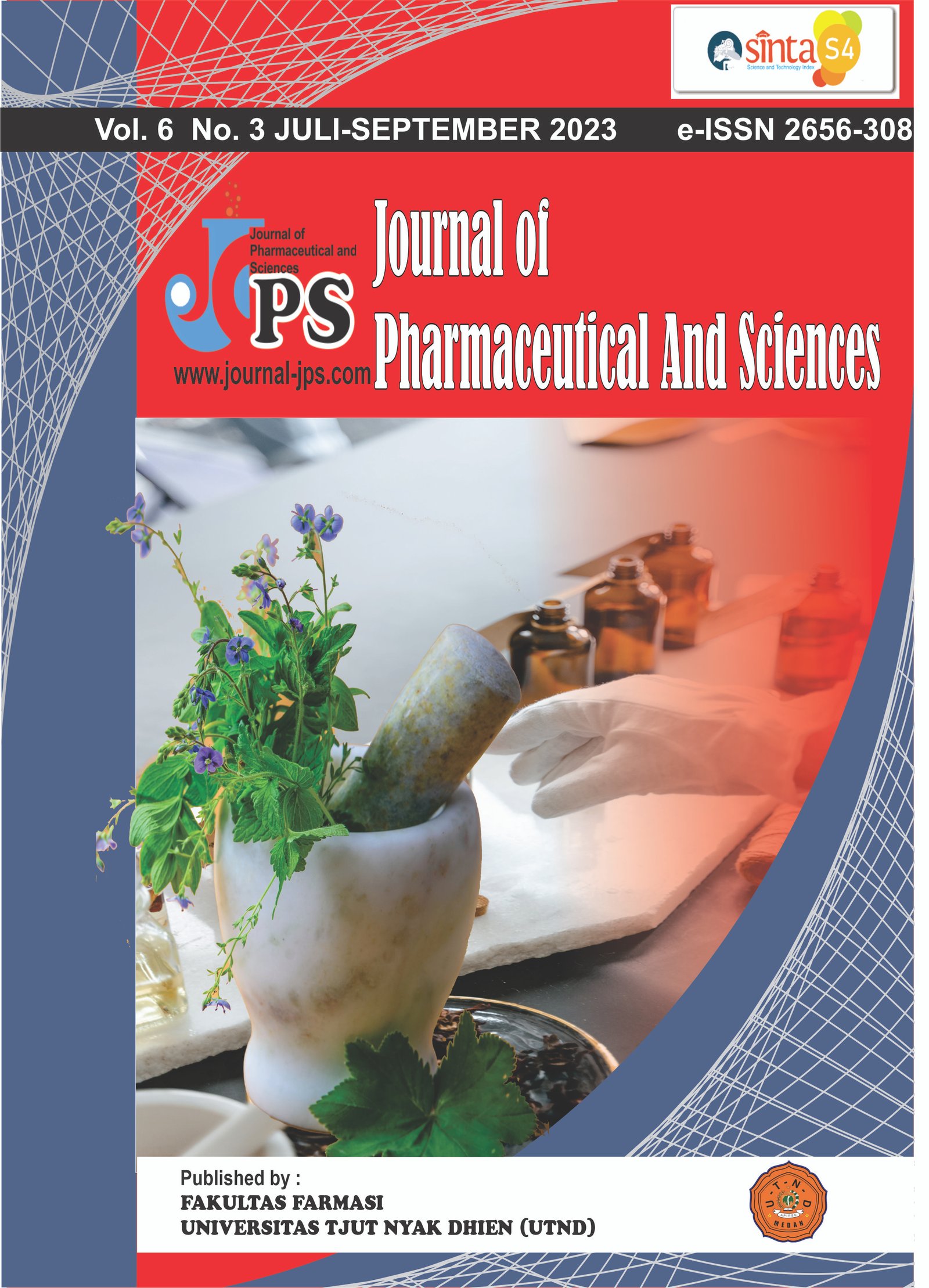Isolation and identification with 16s rRNA gene of endophytic bacteria from papaya (Carica papaya L.) and test of its antibacterial activity
Main Article Content
Page: 1068-1078
Abstract
Endophytic bacteria live symbiotically in host plant tissues and can produce the same bioactive compounds as their host plants, including antibacterial agents. This study aimed to isolate and test the antibacterial activity of endophytic bacteria from the Carica papaya plant and to carry out molecular identification using the 16S rRNA gene against bacterial isolates with the most excellent antibacterial activity. A total of six isolates of endophytic bacteria were successfully separated through the purification process. Through microscopic identification using gram staining, all endophytic bacterial isolates belong to gram-positive bacteria. The results of the antibacterial activity test showed that the six isolates of papaya plant endophytic bacteria could cause the growth of Escherichia coli bacteria but not against Staphylococcus aureus bacteria. The average diameter of the inhibition zone against Escherichia coli bacteria is as follows: RB1: 9.35 mm; RB2: 9.4mm; RB3: 9.15mm; CB1: 9.1mm; CB2: 9.2mm; CB3: 8.8mm; FB1: 8.45mm; FB2: 8.75mm; and FB3: 8.6mm. All papaya plant endophytic bacterial isolates had an inhibition zone categorized as weak. Bacterial isolate RB2, which has the most excellent antibacterial activity, is identified molecularly as Bacillus cereus.
Downloads
Article Details

This work is licensed under a Creative Commons Attribution-NonCommercial-ShareAlike 4.0 International License.
References
Chebotar, V. K., N. V. Malfanova, a. V. Shcherbakov, G. a. Ahtemova, a. Y. Borisov, B. Lugtenberg, and I. a. Tikhonovich. 2015. “Endophytic Bacteria in Microbial Preparations That Improve Plant Development (Review).” Applied Biochemistry and Microbiology 51 (3): 271–77.
Clarridge, J. E. 2004. Impact of 16S rRNA Gene Sequence Analysis for Identification of Bacteria on Clinical Microbiology and Infectious Diseases. Clin. Microbiol. Rev.17(4): 840-862.
Diyan Y, Fajriyah N, Wahyuni D, Murdiyah S. 2015. Pengaruh Kombucha Sari Buah Belimbing Wuluh (Averrhoa Bilimbi) terhadap Pertumbuhan Bakteri Escherichia coli. Universitas Jember. XIII (2):32–6.
Harvianti, Y. 2017. Identifikasi Molekuler Bakteri Endofit Penghasil Fitase Asal Tanaman Jagung (Zea mays L.) Berbasis Gen 16S rRNA. Skripsi. Fakultas Sains Dan Teknologi Uin Alauddin. Makassar.
Herny C. R, Yudistira, A., Herny E. I. S., 2018, Isolasi, IdentifikasiSecara Molekuler Menggunakan Gen 16s rRNA, Dan Uji Aktivitas Antibakteri BakteriSimbion Endofit Yang Diisolasi Dari Alga Halimeda opuntia PHARMACON Jurnal Ilmiah Farmasi – UNSRAT Vol. 7 No. 2
Kusumawati DE, Fachriyan HP, Maria B. 2014. Aktivitas antibakteri isolate bakteri endofit dari tanaman miana (Coleus scutellariodes L. Benth.) terhadap Staphylococcus aureus dan Escherichia coli. Journal Current Biochemistry. 1(1): 45-50.
Mahardika, I.G. Ngurah K. 2005. Polymerase Chain Reaction. Jurnal Veteriner Vol.4 No. 1 : Bali
Martiasih Maria, Boy Rahardjo Sidharta, P. Kianto Atmodjo.2012.Aktivitas Antibakteri Ekstrak Biji Pepaya terhadap Escherichia coli dan Streptococcus pyogenes. Jurnal Ilmiah Mahasiswa Fakultas Teknobiologi Universitas Atma Jaya, Yogyakarta
Nirosha N, Mangalanayaki R. 2013. Antibacterial Activity of Leaves and Stem Extract of CaricapapayaL. International Journal of Advance in Pharmacy, Biology, and Chemistry. 2(3):473-76.
Noverita, Fitria, D., Sinaga, E. 2009. Isolasi dan Uji Aktivitas Antibakteri Jamur Endofit dari Daun dan Rimpang Zingiberottensii Val. Jurnal FarmasiIndonesia. 4(4): 171-176.
Peter JK, Kumar Y, Pandey P, Masih H. Antibacterial Activity of Seed and Leaf Extract of Carica papaya var. Pusa dwarf Linn—Journal of Pharmacy and Biological Science.2014;9(2):29 37.
Pratiwi EW, Praharani D, Arina YM. 2015. Daya Hambat Ekstrak Daun Pepaya Carica papaya L.) terhadap Adhesi Bakteri Porphyromonas gingivalis pada Neutrofil. Jurnal Pustaka Kesehatan Universitas Jember.;3(2):193-198.
Rahayu, D. A. dan Nugroho, E. D. 2015. Biologi Molekuler dalamPerspektif Konservasi Plataxia, Yogyakarta.
Rini A, Supriatno, Rahmatan H. 2017. Skrining Fitokimia dan Uji Antibakteri Ekstrak Etanol Buah Kawista (Limonia Acidissima L.) dari Daerah Kabupaten Aceh Besar terhadap Bakteri Escherichia coli. Jurnal Ilmiah UNSYIAH. 2(1):1-11
Ruby, E Jalgaonwala. 2011. “A Review: Bacterial Endophytes and Their Bioprospecting.” Journal of Pharmacy Research 4 (3): 795–99.
Simarmata R, Lekatompessy S, Sukiman H. 2007. Isolasi mikroba endofitik dari tanaman obat sambung nyawa (Gynura procumbens) dan analisis potensinya sebagai antimikroba. Berkala Penelitian Hayati. 13: 85-90.
Sunatmo, T. I. 2007. Eksperimen mikrobiologi dalam laboratorium. Penerbit Ardy Agency, Bogor.
Tan, R. X. dan Zou, W. X. 2001. Endophytes: A Rich Source of Functional Metabolites. Natural Product Reports. 18: 448-459.
Tuntun M. 2016. Uji Efektivitas Ekstrak Daun Pepaya (Carica papayaL.) terhadap Pertumbuhan Bakteri Escherichia coli dan Staphylococcus aureus. Jurnal Kesehatan Politeknik Kesehatan Tanjung karang; VII(3):4 97-502.
World Health Organization. 2015. Global Action Plan On Antimicrobial Resistance. USA: Halaman 10-11.
Wuluyo Lud. 2008, Teknik dan Metode Dasar dalam Mikrobiologi. Malang: Unicersitas Muhammadiyah Malang.





